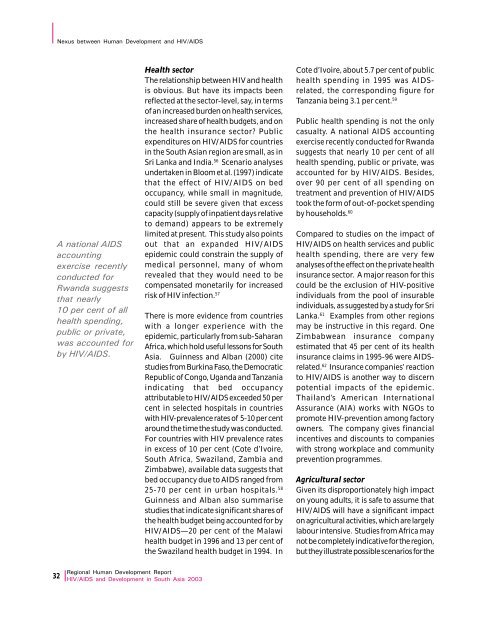Download Report - UNDP Asia-Pacific Regional Centre - United ...
Download Report - UNDP Asia-Pacific Regional Centre - United ...
Download Report - UNDP Asia-Pacific Regional Centre - United ...
You also want an ePaper? Increase the reach of your titles
YUMPU automatically turns print PDFs into web optimized ePapers that Google loves.
Nexus between Human Development and HIV/AIDSA national AIDSaccountingexercise recentlyconducted forRwanda suggeststhat nearly10 per cent of allhealth spending,public or private,was accounted forby HIV/AIDS.Health sectorThe relationship between HIV and healthis obvious. But have its impacts beenreflected at the sector-level, say, in termsof an increased burden on health services,increased share of health budgets, and onthe health insurance sector? Publicexpenditures on HIV/AIDS for countriesin the South <strong>Asia</strong>n region are small, as inSri Lanka and India. 56 Scenario analysesundertaken in Bloom et al. (1997) indicatethat the effect of HIV/AIDS on bedoccupancy, while small in magnitude,could still be severe given that excesscapacity (supply of inpatient days relativeto demand) appears to be extremelylimited at present. This study also pointsout that an expanded HIV/AIDSepidemic could constrain the supply ofmedical personnel, many of whomrevealed that they would need to becompensated monetarily for increasedrisk of HIV infection. 57There is more evidence from countrieswith a longer experience with theepidemic, particularly from sub-SaharanAfrica, which hold useful lessons for South<strong>Asia</strong>. Guinness and Alban (2000) citestudies from Burkina Faso, the DemocraticRepublic of Congo, Uganda and Tanzaniaindicating that bed occupancyattributable to HIV/AIDS exceeded 50 percent in selected hospitals in countrieswith HIV-prevalence rates of 5-10 per centaround the time the study was conducted.For countries with HIV prevalence ratesin excess of 10 per cent (Cote d’Ivoire,South Africa, Swaziland, Zambia andZimbabwe), available data suggests thatbed occupancy due to AIDS ranged from25-70 per cent in urban hospitals. 58Guinness and Alban also summarisestudies that indicate significant shares ofthe health budget being accounted for byHIV/AIDS—20 per cent of the Malawihealth budget in 1996 and 13 per cent ofthe Swaziland health budget in 1994. InCote d’Ivoire, about 5.7 per cent of publichealth spending in 1995 was AIDSrelated,the corresponding figure forTanzania being 3.1 per cent. 59Public health spending is not the onlycasualty. A national AIDS accountingexercise recently conducted for Rwandasuggests that nearly 10 per cent of allhealth spending, public or private, wasaccounted for by HIV/AIDS. Besides,over 90 per cent of all spending ontreatment and prevention of HIV/AIDStook the form of out-of-pocket spendingby households. 60Compared to studies on the impact ofHIV/AIDS on health services and publichealth spending, there are very fewanalyses of the effect on the private healthinsurance sector. A major reason for thiscould be the exclusion of HIV-positiveindividuals from the pool of insurableindividuals, as suggested by a study for SriLanka. 61 Examples from other regionsmay be instructive in this regard. OneZimbabwean insurance companyestimated that 45 per cent of its healthinsurance claims in 1995-96 were AIDSrelated.62 Insurance companies’ reactionto HIV/AIDS is another way to discernpotential impacts of the epidemic.Thailand’s American InternationalAssurance (AIA) works with NGOs topromote HIV-prevention among factoryowners. The company gives financialincentives and discounts to companieswith strong workplace and communityprevention programmes.Agricultural sectorGiven its disproportionately high impacton young adults, it is safe to assume thatHIV/AIDS will have a significant impacton agricultural activities, which are largelylabour intensive. Studies from Africa maynot be completely indicative for the region,but they illustrate possible scenarios for the32<strong>Regional</strong> Human Development <strong>Report</strong>HIV/AIDS and Development in South <strong>Asia</strong> 2003
















